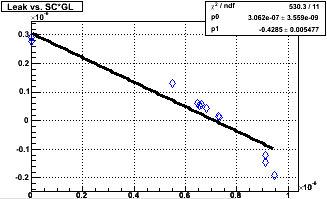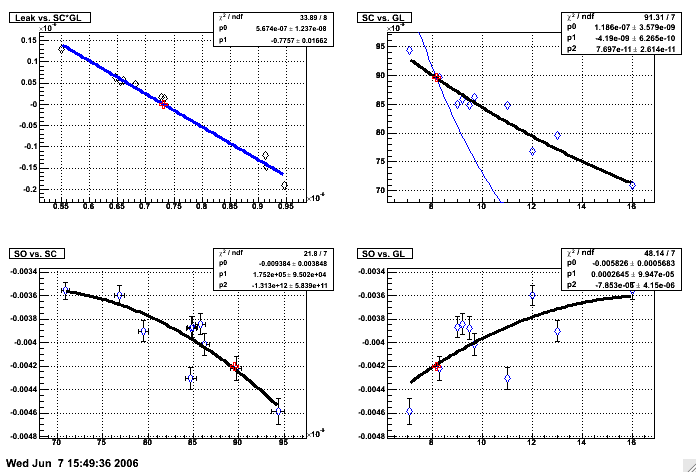pp2006: longitudinal polarization
Updated on Mon, 2006-06-12 14:29. Originally created by genevb on 2006-05-30 10:48.
Under:
Using the calibration technique described SpaceCharge and GridLeak Calibration How-To Guide, I made several passes on data from the longitudinal polarization running. This was the first dataset from the 2006 running which I calibrated, and there were a few items to note during this calibration process:
Excluding the no-correction data, here are the plots and output from my final iterative pass (after enough iterations to stabilize the fits):
- No beamline constraint was yet available while I did the calibration. Instead, a beamline fixed to the z-axis was used. This should bias the vertex positions, but as long as tracks used in this calibration come from all azimuth angles, there should only be a smearing of the DCA distributions, not a bias.
- Distortions were larger than ever before, so histogram ranges needed expanding.
- Spread in the measures of the GridLeakage and SpaceCharge ionization were larger than I found when calibrating CuCu22 from last year, so I had to open the cuts used in the Calib_SC_GL.C macro (from 0.005 and 0.0003 respectively for CuCU22, to 0.015 and 0.0015 for this data). The SpaceCharge cut in particular had to be significantly widened. I though that this might be because of the uncalibrated beamline constraint, which introduces a smearing of a few mm into the primary vertex DCA distribution used to determine SpaceCharge, but a later test using the beamline constraint did not significantly narrow this distribution.
- For the first pass of this calibration, I used Fast Offline data which had no SpaceCharge and GridLeak corrections. While the first pass was somewhat useful to suggest where to start with SpaceCharge and GridLeak
correction parameters, I had to remove the first pass data points from the eventual iterative pass fits
because the distortion is so strong that without correction we actually lose tracks with large GridLeak gaps,
biasing our measure of the distortion. This can be seen in the following plot of measured distortion gap versus
the amount of GridLeak correction used (as expressed by SC*GL), where the no-correction points significantly
alter the straight-line fit:

It may also be true that the StMagUtilities code used to correlate distortions to the ionization has issues when the GridLeak gap is large. Work is in progress to improve this particular code.
Excluding the no-correction data, here are the plots and output from my final iterative pass (after enough iterations to stabilize the fits):
* Constraint on SC x GL = 7.31e-07
* Guesses on SC = 8.9e-08 , 3.95e-08 , 8.96e-08 , 3.95e-08
* Guesses on SO = 4.68e+04 , 4.72e+04
*** FINAL CALIBRATION VALUES: ***
SC = 8.96e-08 * ((zdce+zdcw) - (4.7e+04)) with GL = 8.2»
- Printer-friendly version
- Login or register to post comments

